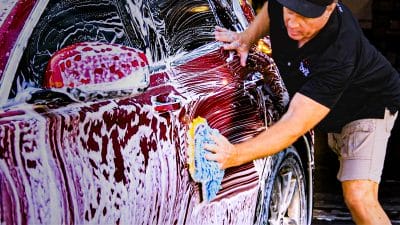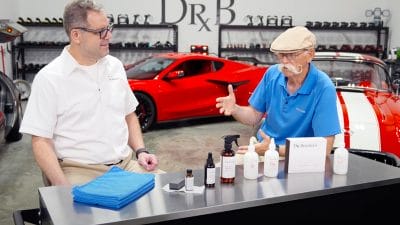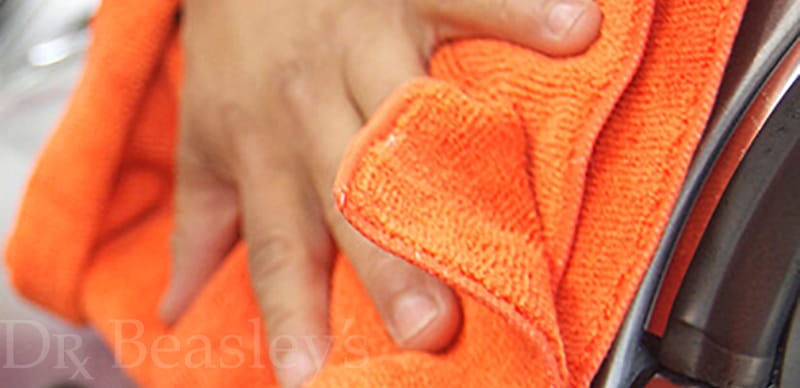Last Updated June 7, 2023
In 2012 we published a blog post entitled “Why Chamois Are A Sham”. In this blog we advised against using chamois, instead recommending microfiber towels. The reasons provided focused generally on chamois’ lack of knap and its difficulty to maintain. Since then, we’ve had a good number of responses in the comments taking issue with our characterization of chamois and microfiber towels.
We thought it might be a good idea to tackle some of these responses to provide an updated look at the age-old “Chamois vs. Microfiber” debate. Let’s take a look!
CLAIM: Chamois actually DOES have knap.
REALITY: This is half true. When producing chamois, some manufacturers employ a buffing process that opens up its fibers, allowing dirt to be sucked up and not scratch your paint. However, not all manufacturers buff their chamois, so if you made the mistake of buying a non-buffed chamois, you could possibly scratch your paint with leftover particles.
CLAIM: Microfiber is actually more difficult to maintain, requiring special detergent, separating loads of different kinds of towels, specific heat settings, etc.
REALITY: Where to begin? First you do not need a special detergent for your microfiber towels. Yes, many companies offer detergent specifically designed for microfiber, but generally speaking you’d be fine using a mild detergent with no fabric softener. Yes, you do need to separate your towels based on their use, but is that really so difficult? Advising against microfiber just because you need to separate your loads is like saying you should never wear white clothes because you have to wash them separately. As for heat settings, yes, some microfiber towels require specific settings. But so do your clothes, and you wash those at least once a week! Who cares if you need to fiddle with your washer’s heat settings once or twice a month!
CLAIM: So what if chamois drag dirt and rocks across your paint? If you were a real detailing pro, you wouldn’t have missed any particles on your car during the rinse.
REALITY: No one is perfect! There is always a chance some abrasive particle failed to come off in the rinse, no matter how diligent you were. If you’re truly a detailing pro, you know to never leave your car’s paint job to chance!
CLAIM: Microfibers don’t last long! Mine started to scratch after 3-5 uses!
REALITY: If you bought a quality microfiber towel (like the ones we sell on the Dr. Beasley’s store) it should last far longer than that. If it’s scratching that quickly, it’s probably low-quality.
CLAIM: Chamois lasts far longer than an microfiber towel.
REALITY: Sort of true. With the right maintenance, a chamois can last a lifetime. But if you make even one mistake maintaining it, you could scratch your car’s paint. What if you didn’t get it completely damp before drying, and some part of it remained hard and crusty? You’re screwed! Not to mention these boys are made of actual animal skin, so you also run the risk of your chamois starting to rot. Nasty.
CLAIM: Synthetic chamois eliminate the issues associated with natural chamois.
REALITY: Far from the truth. Synthetic chamois are actually much worse for your paint, as they lack any knapping ability whatsoever.
CLAIM: You need multiple microfiber towels to dry your car, while chamois can be simply wrung out and used again.
REALITY: While it’s true chamois can be wrung out and used again in the same drying session, wouldn’t it be easier/faster to just discard your used towel, pick up a new one, and move on?
CLAIM: Microfiber, chamois, who needs it? Just use a leafblower/diapers/[insert unconventional drying method here]!
REALITY: Hoo boy. I’ve been seeing a lot of people extolling the virtues of the leafblower as a drying method, and I just don’t understand why. Gas leafblowers use (you guessed it!) gasoline, which more often than not can get kicked up into the air being shot at your car. Think you can get away with using an electric instead? Well, you still run the risk of particles in the air being sucked up into the exhaust and scratching your paint. An air-filter might minimize this possibility, but do you really want to risk it? As for cloth diapers, while you may think it’s an ingenious repurposing of a household item, they have no knap and fall prey to the same risk of dragging particulates across your paint.
So, in conclusion, while we were off on the knapping ability of natural chamois (or at least properly buffed chamois), when it comes to the chamois vs. microfiber debate, we stand by our conviction that microfiber towels are the best method for drying your car. Chamois may not be the worst thing to dry with, but microfiber towels are far more foolproof.





I have been using chamois for over 50 years. You were correct in saying there is more maintenance with the chamois but it is worth it. I just retired a chamois that I have been using for about 15 or so years and it was just worn out. semi retired. It is still good for glass. The one I replaced it with is very good quality, maybe even better than the one I replaced, and it works like a dream. One thing I like about chamois is the glass cleaning ability. I think it all comes down to a personal opinion. If you don’t mind caring for it the chamois can last for years. Just be sure to rinse it out as you are drying your car and make sure it is dry before storing, and you should not have to worry about dirt particles. Good article.
I had one for years just got to rinse it good squeeze the water out then hang in cooldry place.Never a scratch.
How do I know if I have a good chamois or not?. If I go to get another what brand do you suggest?. Thank you!!!.